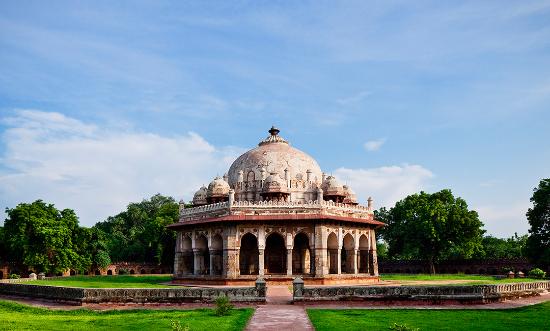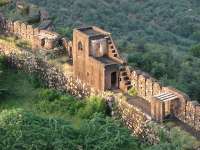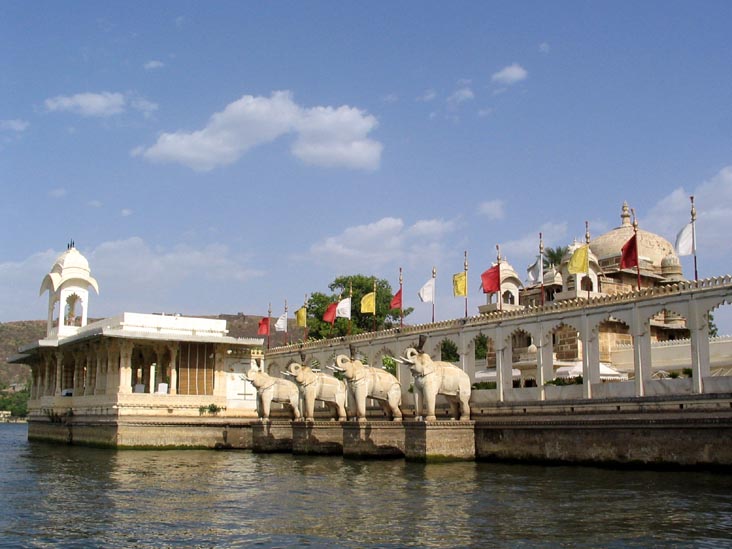|
While on a North India Tour, the Delhi-Jaipur-Udaipur tour is one of the most preferred itineraries. It lets you enjoy the wonder of the splendid state of Rajasthan and the capital of the nation, Delhi. While Jaipur packages take you around magnificent forts, beautiful havelis and colourful bazaars, it even let you visit the sacred city of Pushkar, home to Lord Brahma. Pushkar houses the only temple in the world dedicated to Brahma. A Trip to the famous Lake Pichola and the marvelous Lake Palace are included in the Udaipur Tours. When on a North India Tour, a trip to the Delhi-Jaipur-Udaipur takes you on a royal ride.
Delhi Red Fort, Chandni Chowk, Humayun's Tomb, India Gate
Jaipur: Jantar Mantar, Jagat Shiromani Temple, Jaigarh Fort, Jal Mahal
PushkarPushkar Fair, Pushkar Lake, Brahma Temple, Pushkar
Ajmer Ana Sagar Lake, Taragarh Fort, Dargah Shariff
ChittorgarhFort Of Chittorgarh, Gaumukh Reservoir, Meera Temple (Meera Mandir)
Udaipur: City Palace, Jag Mandir, Fateh Sagar,Lake Pichola, Jagdish Mandir |
|
Delhi:
Being one of the most historic capitals in the world, Delhi has many tourist sites. This is a list of Delhi's tourist sites.In Old Delhi, there are attractions like mosque and monuments that represent India's history.  The important places in Old Delhi include the majestic Red Fort. New Delhi, on the other hand, is a modern city designed by Edwin Lutyens and Herbert Baker. New Delhi houses many government buildings and embassies, apart from places of historical interest.
The Qutub Minar, Red Fort and Humayun's Tomb are listed as UNESCO World Heritage Sites.
India Gate and Rajpath
India Gate is a memorial raised in honour of the Indian soldiers who died during the Afghan wars and World War I. The names of the soldiers who died in these wars are inscribed on the walls. The green lawns at India Gate are a popular evening and holiday rendezvous for young and old alike. Every year the Republic day celebrations are made in Delhi.
Rashtrapati Bhawan
Built with a mix of European and Mughal/Indian styles, Rashtrapati Bhavan was originally built for the Governor General of India. Inaugurated in 1931 as the Viceregal Lodge, the name was changed in 1959 after India became a republic. Now it is the Presidential Palace of India.Chandni Chowk, a main marketplace in Delhi, keeps alive the city's living legacy of Shahjahanabad. Created by Shah Jahan the builder of Taj Mahal, the old city, with the Red Fort as its focal point and Jama Masjid as the praying centre, has a fascinating market called Chandni Chowk. The market was divided by canals. The canals are now closed, but Chandni Chowk remains Asia's largest wholesale market. With the most famous mosque of Delhi Jama Masjid in the vicinity, along with Sis Ganj Gurudwara, Gauri Shankar Mandir, Jain Mandir and a lot of small temples, the place witnesses a genuine cultural harmony.
Safdarjung's Tomb
|
Jaipur:
City Palace:Upon visiting the magnificant City Palace, it's easy to see that the royal family of Jaipur was one of the richest in India.
The huge complex of courtyards, gardens, and buildings blend both Rajasthani and Mughal architecture.
"Hawa Mahal" Palace of the Winds
Martin Harvey/Getty Images
The intricate and fascinating facade of the Palace of the Winds is probably Jaipur's most recognized building. Constructed in 1799, it has five floors that contain rows of small windows and screens. Wind used to flow through the openings, giving the palace its name.
Galta Monkey Temple
Elke Van de Velde/Getty Images
Getting to this rather ruinous but holy Hindi temple, nestled in peaceful surroundings between two granite cliffs, is quite an adventure but it's completely worth the effort.
Amber Fort and Palace
It was the original home of Rajput royalty until Jaipur city was constructed, and contains a number of breathtaking palaces, halls, gardens, and temples.
|
Pushkar:
Pushkar has many temples. Most of the temples are not very old because many temples were destroyed during Muslim conquests in the area.
Subsequently, the destroyed temples were rebuilt. The most famous among all is the Brahma Temple built during the 14th century CE. Very few temples to Lord Brahma exist anywhere in the world. Other temples of Brahma include Bithoor in Uttar Pradesh, India; Khedbrahma in Gujarat, India; village Asotra near Balotra city of Barmer district in Rajasthan; Uttamar Kovil (one of the Divya Desams) near Srirangam, Tamil Nadu; Mother Temple of Besakih in Bali, Indonesia; and Prambanan in Yogyakarta, Indonesia. The Pushkar lake has 52 ghats where pilgrims descend to the lake to bathe in the sacred waters
|
Ajmer
 Dargah Sharif: One of the country’s most famous pilgrim centres, the Dargah Sharif of the Sufi saint Khwaja Moin-ud-Din Chishti is the centre of the Ajmer Urs festival. Apart from the Akbari Masjid, the tomb of the saint and the gate, the other marble structures within the complex of the dargah have fine impressions of Mughal architecture. Dargah Sharif is the most famous pilgrim and tourist centre in Ajmer.
Tarangarh Fort: Constructed in 1354, parts of the fort lie in ruins. However Rajasthani architecture during the rule of the Chauhan dynasty is easily seen in the Rani Mahal and Miran Saheb ka Dargah. Many parts of the fort remain inaccessible. Taragarh Fort is the first hill fort in Asia.
Lakes: Foy Sagar and Ana Sagar apart from being the chief sources of water for Ajmer, also serve as great picnic spots with its scenic beauty. While Ana Sagar was constructed by Shah Jahan in the 12th century by blocking the water of Luni River, Foy Sagar was constructed in the 19th century by Mr Foy as a part of a drought relief project.
|
Chittorgarh:
Chittorgarh Fort:IT is the epitome of Rajput pride, romance and spirit. It reverberates with history of heroism and sacrifice, which is evident as it echoes with the
tales sung by the Bards of Rajasthan. The main reason for visiting Chittorgarh is its massive hilltop fort, which is a depiction of Rajput culture and values.
Gaumukh Reservoir:
Gaumukh ReservoirA deep tank filled by a spring coming from a 'cow mouth', situated at the edge of the cliff. It is considered to be sacred where you can feed the fishes.
Meera Temple
Meera TempleBuild by Maharana Kumbha in 1449, this lord Vishnu Temple has beautiful idols in its sanctum, mendap and pillars. In the same premises, there is a small temple of Lord Krishhna.
|
Udaipur:
 Udaipur is often called ‘Venice of the East’. It is also the ‘city of lakes’. The Lake Palace (Jag Niwas) located in the middle of Pichola Lake is the finest example of architectural and cultural marvel. The grand City Palace on the banks of the lake along with the Monsoon Palace (Sajjan Garh) on the hill above enhances the beauty of this magnificent city. Udaipur is also the centre for performing arts, crafts and its famed miniature paintings. The Shilpgram festival is a great crowd-puller on new year
Kumbhalgarh is located 84 km North of Aravalli hills in Udaipur and houses the colossal Kumbhalgarh Fort – an important landmark of Mewar rulers. The fort was built in 15th century by Maharana Khumbha and was used to protect the Rajput warriors at the time of danger.
Udaipur Solar Observatory (USO), situated on an island in the Fateh Sagar Lake, is considered as the best solar observing site in Asia. It is also among the few in the world that are situated on an island.
This beautiful three-storied Palace, located on the southern island of Lake Pichola and made in yellow sandstone and marble, has significant historical relevance. Built in early 17th century, Jag Mandir Palace was raised by Maharana Karan Singh to serve as a refuge for Prince Khurram, who later became popular as Emperor Shah Jahan.
|